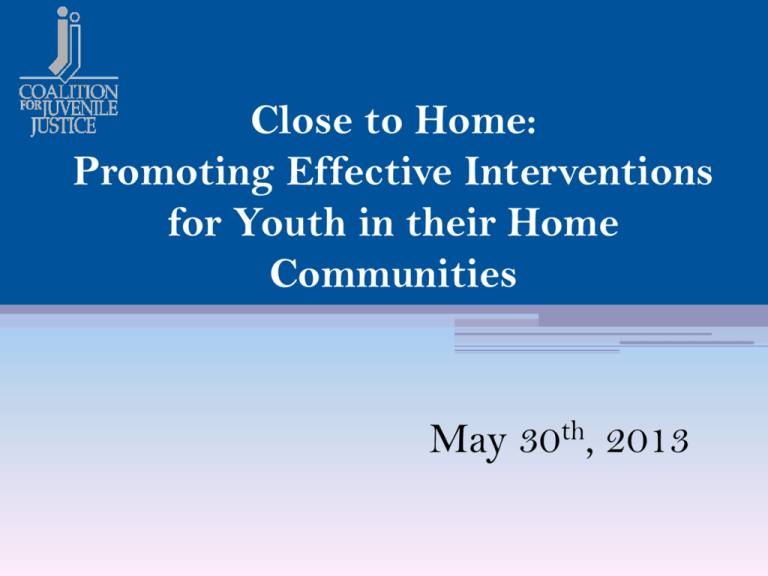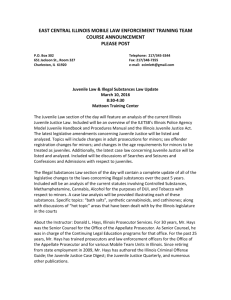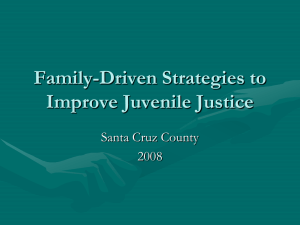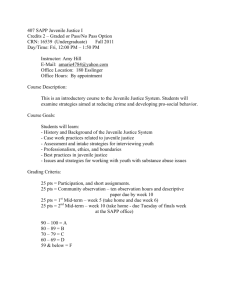here - Juvenile Justice Initiative
advertisement

Close to Home: Promoting Effective Interventions for Youth in their Home Communities May 30th, 2013 Agenda Introduction Marie Williams, Deputy Executive Director, Coalition for Juvenile Justice National Implications of the Close to Home Approach (15 mins) Elizabeth Clarke, Juvenile Justice Initiative of Illinois Close to Home in New York (20 mins) Vincent Schiraldi, Commissioner, NYC Department of Probation The Role of State Advisory Groups (10 mins) Esther Franco-Payne, Metropolis Strategies, Illinois SAG Q&A (15 mins) Redeploy Illinois & Implications for National Trends Elizabeth Clarke, Juvenile Justice Initiative Illinois The Problem in Illinois • Confinement Expensive ▫ $70,000 and up/year/bed • Confinement Ineffective ▫ Over 50% repeat offending rate The Problem . . . • Overreliance on Confinement due to lack of local alternatives ▫ Nearly 30% of juvenile correctional population committed for court ordered mental health evaluation (“bring-back” orders) ▫ 10%-12% of the youth correctional population comprised “court evals” • Fiscal structure encouraged committing youth to statefunded corrections rather than finding a local (county) solution. • If a youth is sent to the state, it costs the county less, when community-based alternatives are lacking. Research • The Illinois Department of Corrections documented overreliance on corrections for youth…..particularly youth committed for “evaluation” • Research documented success of alternatives to detention in IL. – particularly evening reporting centers • Research documented success of evidence -based programming – i.e. Multi-Systemic Therapy, Family Functional Therapy Developing a Consensus for Change • Early on (mid-1990s), RECLAIM Ohio emerged as an interesting model for y0uth corrections reform in Illinois • 2003 – JJ reformers host series of discussions with key stakeholders in government, service, university, and advocacy sectors; Illinois legislators involved • Public education & coalition building -- regional public opinion polls, legislative hearings, regional summits Principles • Restorative justice • Youth should be treated in least restrictive manner • Continuum of services and sanctions in communities; local options • Local responsibility • Public safety/accountability • Program accountability Implementation • Redeploy Oversight Board: Judges, Prosecutors, Probation, County, State agency representatives from child welfare and corrections, youth advocacy organizations, researchers • Application Process: ▫ Series of public hearings to solicit input from community leaders on Redeploy Illinois - this community input was integrated into RFP process ▫ Public hearings all held in sites of pilot DMC communities • Applications: ▫ Hesitation of counties to apply due to the possible implementation of penalties First Year Results • 4 pilot sites: 3 counties & one judicial circuit (which included 12 counties) • Overall a 33 percent reduction in juvenile commitments to state corrections; no evidence of significant increase in local detention utilization Second Year Results • 44% reduction in commitments Redeploy in Operation Today • Original 4 sites expanded to 8 sites covering 28 counties • Planning grants initiated – requirement that site must conduct a planning grant assessment prior to submitting proposal • Active involvement of Oversight Board • Tech assistance provided via “All Sites” mtngs • Youth incarceration reductions continue to exceed 25%....with a 51% reduction over baseline in Redeploy sites since 2006. • All sites use a common assessment tool (YASI) • All sites use evidence-based programming • All sites have increased local collaboration What are the national implications of the Redeploy Illinois and Close to Home experiences? Shift to Use of Incarceration as a Last Resort • Legislators and policymakers increasingly aware: ▫ That U.S. incarcerates at five times the rate of next closest nation ▫ That incarceration is too expensive to use except as a last resort – and a pressing need to realign limited state resources to community based alternatives ▫ That incarceration – especially of low level offenders – is a failed policy States rapidly closing/downsizing • Washington DC saved $18.5 million between ’05-’09 by closing Oak Hill, a 188 bed facility, and created a 60 bed facility in a therapeutic and homelike environment with full educational services. • Kansas saved $1.4 million by closing one 66 bed facility for girls, Beloit Juvenile Correctional Facility. The overall juvenile correctional population has now declined by 19% from 410 in 2007 to 332 in 2010. • Indiana saved $4 million annually by closing the N.E. Indiana Juvenile Correctional Facility. • Alabama shifted $2.4 million to community-based programs by decreasing commitments by 55% (from 1,084in ‘07 down to 490). And….. • Arizona saved $2.5 million by closing a facility and decreasing its juvenile correctional population from 600 in ’08 to 400 by ’12. • Arkansas decreased commitments by 20% from ’08-’11. • Connecticut saved $3 million, which was reinvested in programming, by closing a 94 bed facility at New Haven. • Florida saved $130 million by decreasing the number of beds from 6,012 in 2006 to 3,455 in 2011. • Georgia saved $26 million by closing four facilities and downsizing another youth facility. And….. • Missouri saved a half a million annually by closing six juvenile detention facilities. • Ohio saved $57 million by closing four juvenile prisons and downsizing the remaining facilities. The state reinvested the savings in community based programming through Reclaim Ohio and other community alternatives. • South Carolina reduced its youth incarceration population by 71% over the past decade and transferred corrections staff to community program offices. • Wisconsin closed two facilities by reducing its juvenile incarceration by 70% over the past decade. • Illinois reduced its juvenile incarceration by half over the past decade, and is in the process of closing two juvenile prisons, and has already closed one juvenile detention center – all while shifting some state resources to community alternatives through Redeploy Illinois. And….. • And the Big Three: • California decreased the number of youth in confinement by 89%, down from 9,572 in 1996 to 1,082 at end of 2011, and shifted resources to local counties. • Texas closed five facilities and reduced its population from 4,800 in 2006 to 1,798 in 2010, saving the state $115 million. Nearly forty percent of the savings was reinvested in diversion funding in juvenile probation departments. • New York downsized/closed 31 facilities since 2007, recognizing a $58 million savings. Some of the savings is now being realigned to New York City to manage its youth population closer to home, as part of the Close to Home Initiative. Many Factors at play in move to Reduce Reliance on Incarceration: • Fiscal considerations • Research documenting that incarceration is the least effective disposition • Awareness through conditions lawsuits of abuses and lack of services/education in juvenile facilities • Advocacy and education by by human rights advocates • Media attention to failed policies and inadequate conditions • Public opinion polling documenting public support for community alternatives rather than incarceration • Increasing awareness that U.S. stands alone in its heavy reliance on incarceration Push from Fiscal Priorities • Recession in U.S. has caused states to reconsider costly incarceration policies. • Annual cost of bed in juvenile prison in Illinois ranges from $75,000 – over $200,000 depending on facility and number of beds. • Costs go deeper than per bed annual costs – pension benefits for prison guards who are state employees threaten state solvency for decades to come. • Costs of conditions lawsuits (California, Ohio, Texas, Illinois, Arizona) also a factor in fiscal considerations. • A handful of communities benefit from prison jobs, while all communities need alternatives and interventions. Push from Research on What Works • Government and private foundations have invested in research to document the impact of community based alternatives to incarceration. • Evidence based alternatives have proved effective: ▫ MST – multi-systemic therapy and FFT – functional family therapy – work with families to overcome issues that led to behavior in conflict with law ▫ Treatment fidelity is vital ▫ Clinical trials demonstrate reduced short and long term rates of criminal offending ▫ Cost benefit analysis demonstrates significant cost savings compared to incarceration $2.5 savings : $1 spent http://www.jsna.info/download/get/mst-and-fft-evidencereview/15.html Pathways to Desistance • Longitudinal research project, studying 1,354 serious juvenile offenders from age 14-18 over more than 7 years • Funded in part by MacArthur Foundation’s Models for Change Initiative • Findings based on both self-reports and arrest and court records • Youth in conflict with law over range of offenses from violent, including murder, to relatively minor property and drug offenses • Findings document the relative ineffectiveness of longer juvenile incarcerations in reducing juvenile recidivism. • Findings conclude most effective – community based substance abuse treatment • https://ncjrs.gov/pdffiles1/ojjdp/230971.pdf Push from Leadership • Missouri’s Dept. of Youth Services hailed as national model • Child welfare therapeutic approach • Limited use of locked facilities with range of alternative placements including group homes and day treatment • Individualized case planning with counselor following case from beginning to end • Emphasis on pathway to success for positive youth outcome – extensive educational and vocational programs and activities • Criminal records expunged at point of discharge Push from Conditions Lawsuits • Horrific conditions of confinement have forced prison closures/downsizing and reforms in many states, including: ▫ California – officials traveled to Missouri and concluded the conditions in California youth prisons were beyond reform – most have now been closed and savings shifted to community alternatives. ▫ Texas – a bi-partisan legislature passed a massive reform bill that included prohibition on incarceration of misdemeanor offenders and significant reforms. Several facilities have been closed and savings shifted to community alternatives. ▫ Ohio – a bi-partisan legislature passed a massive reform bill that included prohibition on incarceration of low level offenders and a shift of savings from prison closings to community alternatives. ▫ And now Illinois – two lawsuits, one over inadequate conditions in juvenile prisons (inadequate education and mental health programming and excessive discipline practices), and another lawsuit over lack of due process in parole (discharge) process. Push from Advocacy Groups • Particularly concerns over disparate use of incarceration for minority youth. • Nationally, African American youth under age 18 represent 15% of the juvenile population, but make up: • 26% of juvenile arrests • 31% of referrals to juvenile court • 44% of the detained population • 34% of youth formally processed by juvenile court • 46% of youth sent to adult court • 32% of youth adjudicated delinquent • 40% of youth in residential placement • 58% of youth in state adult prisons www.ojjdp.gov/dmc Close to Home NYC Department of Probation Vincent Schiraldi Commissioner, NYC Department of Probation The New York City Close to Home Story Introduction • Background to Close to Home Story • Key Elements of Close to Home • Experiences Thus Far A System in Turmoil • Bronx youth dies in custody at state facility in 2006 • Scathing ACLU/Human Rights Watch study of girls in state facilities entitled “Custody and Control” released in 2006 • US Department of Justice launches investigation and issues highly critical report between 2007-2009 • Legal Aid Society files law suit in 2009 A System in Turmoil, Cont. • Governor’s Task Force issues final report in 2009 • OCFS Commissioner validates concerns • Research studies document high recidivism (66% re-arrested within 2 years and 80% of boys rearrested by age 28) System in Turmoil, Cont. • The next two slides will illustrate the extremely high cost ($260,000 + per year) of placing youth in state custody even as the numbers of youth sent “upstate” dramatically declined over the past decade. • In December 2010, in one of his first acts as Governor elect, Andrew Cuomo visited a fully staffed yet empty Tryon facility, declaring it an icon of government waste. Placement Population Decreasing without Cost Savings Review of National Examples of Realignment • Team from New York visits Wayne County, MI • Literature reviews and interviews with key stakeholders involved with: • Reclaim Ohio • Redeploy Illinois and • California Reinvestment What is Realignment? A shift in responsibility and resources for providing juvenile justice services, supervision, and residential care for adjudicated youth from the state to local governments. A Path to Realignment in New York • Formation of Dispositional Reform Steering Committee in October 2010 • Inclusion of all key Stakeholders (Judges, Defense Bar, Prosecutors, Police, Education, Mental Health, Probation, Children’s Services, Mayor’s Office, Researchers, Advocates, Family Members) • Committee Issues Final Report in 2012 Path to Realignment in New York • Governor signs Close to Home legislation in March 2012 • Non Secure Placement (NSP) Plan submitted to State in June 2012 ▫ Link to Limited Secure Draft Plan: March 2013: http://www.nyc.gov/html/acs/html/close_to_home/close_to_home _links2.shtml ▫ Link to Final Non Secure Placement Plan: http://www.nyc.gov/html/acs/html/close_to_home/close_to_ho me_plan.shtml • 200 + youth placed in non secure programs between 9/12 and 4/13 • Limited Secure Placement (LSP) Draft Plan submitted in March 2013 • Approximately 120 Limited Secure transfers will begin in Fall 2013 Benefits of a Realigned System • Connection to Community • Safer Communities • Better Family Engagement • Access to Counsel • Better educational outcomes • Improved Oversight Probation’s Role in Close to Home • Created graduated levels of probation supervision and services • Implemented objective/validated Pre-Dispositional RAI • Created state-of-the-art Structured Decision Making (SDM) grid that uses risk level and offense severity to guide Probation’s dispositional recommendations to the Court • Expanded continuum of community-based alternatives to placement SDM MATRIX MOST SERIOUS CURRENT ARREST CHARGE LIKELIHOOD OF RE-ARREST (PER YLS ASSESSMENT) HIGH OR VERY HIGH MODERATE LOW BOX #1 Out of Home Placement1 BOX #2 Out of Home Placement or Alternative to Placement BOX #3 Alternative to Placement or Probation (To Be Specified) CLASS II: Non-violent C felonies, violent D felonies BOX #4 Out of Home Placement or Alternative to Placement BOX #5 Alternative to Placement or ESP (Level 3 Probation) BOX #6 Level 1 or 2 Probation CLASS III: Non violent D, All E felonies, misd assault and misd weapons possession BOX #7 Alternative to Placement or ESP (Level 3 Probation) BOX #8 Level 1 or 2 Probation BOX #9 Level 1 Probation or CD CLASS IV: A misdemeanors except assault and weapons and all B misdemeanors2 BOX #10 Level 1 or 2 Probation BOX #11 CD or ACD BOX #12 ACD or short term one time consequence or Dismissal CLASS I: A, B felonies (violent & non-violent), violent C felonies MANDATORY CONSIDERATIONS: 1. Must consider CD or ACD for youth with no unsealed priors. Decision is based on the circumstances of the case. 2. If case goes to trial, use finding offense DISCRETIONARY OVERRIDES: POs have discretion to recommend either a more or less restrictive option than the grid provides. However, all overrides - up or down - must be submitted with justification for approval to the PO’s supervisor and Borough Director 1 All placement related processes will be handled by ACS of these cases should be adjusted at intake 2 Many Shaded boxes represent youth who are eligible for DOP’s and ACS’s ATP programs Three new ATPs will be added to create a robust array of interventions for delinquent youth at all risk/offense levels. 43 Experiences in Implementing Close to Home Since September 2012 • 7 of 11 providers utilizing “Missouri Model” • Learning curve for many providers serving exclusively delinquent youth • Educational gains - credits earned toward high school graduation • Attendance at school post-placement is higher than for kids placed in secure or non-secure detention • Behavioral issues in schools – competing modalities with treatment providers • SDM grid allows us to study patterns of decision-making and to determine whether race or gender play a role in dispositional recommendations A total of 111 of the 168 NSP high school students have earned high school credits while at Passages Final Dispositions by YLS Risk Level, May 2012 through February 2013 Dispositional overrides of SDM recommendations, by cell, April 2012 through April 2013 MOST SERIOUS CURRENT ARREST OFFENSE CLASS I: A, B felonies (violent & non-violent), violent C felonies CLASS II: Non-violent C felonies, violent D felonies CLASS III: Non violent D, All E felonies, misd assault and misd weapons possession CLASS IV: A misdemeanors except assault and weapons and all B misdemeanors LIKELIHOOD OF RE-ARREST (PER THE RAI) HIGH MEDIUM Box 1: Box 2: Out of Home Out of home Placement or ATP placement (0 out of 49 total (0 out of 7, for Boxes 2 and 4, 0.0%) 0.0%) Box 4: Out of Home Placement Box 5: ATP or ESP or ATP (8 out of 66 total (0 out of 49 for Boxes 5 and 7, total for Boxes 2 12.1%) and 4, 0.0%) Box 7: ATP or Box 8: Level 1 or 2 ESP Probation (8 out of 66 (51 out of 163 total total for Boxes 5 for Boxes 6, 8, and and 7, 12.1%) 10, 31.3%) Box 10: Level 1 or 2 Probation Box 11: CD or ACD (51 out of 163 (43 out of 67, total for Boxes 64.2%) 6, 8, and 10, 31.3%) LOW Box 3: ATP or Probation (0 out of 23, 0.0%) Box 6: Level 1 or 2 Probation (51 out of 163 total for Boxes 6, 8, and 10, 31.3%) Box 9: Level 1 Probation or CD (21 out of 58, 36.2%) Box 12: ACD or short-term consequence or Dismissal (11 out of 28, 39.3%) Six Month Re-Arrest Rates Among Youth Opened for Adjustment in Jan-June 2012, by SDM cell Role of the State Advisory Groups Esther Franco-Payne, Metropolis Strategies, Illinois SAG • The Illinois Juvenile Justice Commission (IJJC) is composed of 25 volunteers and professionals in the field of juvenile justice who are appointed by the Governor. The IJJC: ▫ Advises the Governor, the General Assembly and the Illinois Department of Human Services on policies and practices related to the Illinois juvenile justice system. ▫ Is designated as the state advisory group (SAG)--required by the Juvenile Justice and Delinquency Prevention Act (JJDPA) to work in partnership with OJJDP. ▫ Develops and implements Illinois’ three-year JJDPA plan and administers federal JJDPA grant funds in Illinois. ▫ Administers the federal Juvenile Accountability Block Grants Program in Illinois The key strategies to accomplish the IJJC’s goals include: • Policy -- Research, data analysis and reporting should guide the development of effective and evidence-based juvenile justice policy in Illinois. • Practice -- By strengthening and creating new collaborative efforts with the many participants in the juvenile justice system and by helping with training and technical assistance, the Commission can foster the implementation of effective, evidence-based practices. • Programs-- The Commission will support continued research, implementation of innovative models, the diffusion of effective programs, and the development of best practices on emerging issues. Serious Challenges Facing our Communities in Illinois • Around 1,500 youth are on juvenile parole or aftercare statewide • About 68% of youth who leave an Illinois DJJ facility are reincarcerated within 3 years DJ J DJ J What isn’t working? • The current system doesn’t treat our youth like the children they are 1. 2. 3. 4. Adult surveillance parole system Parole is revoked for “technical violations” Children spend too long on parole Youth and communities are shut out of the process IJJC Recommendations 1. Instead of an Adult Based Surveillance System, expand Aftercare 2. Instead of returning youth to prison, use graduated sanctions for minor violations 3. Instead of remaining on parole until 21, youth should be off parole after a year 4. Instead of going through parole revocation hearings alone, youth need to exercise their rights Raise the Age Report • Released in February 2013 ▫ Before 2010, all 17-year-olds were in the criminal adult system. Analyzes a change that moved only some 17year-olds from adult to juvenile court ▫ Recommends treating 17-year-olds as juveniles for ordinary offenses, avoiding permanent felony records and increasing fairness and public safety Summary of Findings • Raising the age ▫ is consistent with legal trends ▫ is consistent with adolescent development and behavior ▫ is an efficient use of juvenile court resources improves public safety decreases long-term costs • Raising the age for misdemeanors (2010) ▫ did not overwhelm the juvenile justice system ▫ created inconsistencies and uncertainty • Raising the age for felonies (future) ▫ anticipated to be manageable ▫ will promote uniformity, clarity ▫ does not affect transfer for serious offenses Support for a Community-Based Approach for System-Involved Youth The Illinois Juvenile Justice Commission continues to be responsive to opportunities to improve Illinois’ juvenile justice system in policy and practice by creating partnerships and collaborating with decision makers, systems’ stakeholders, advocates and communities impacted by the system. Questions For more information • On Redeploy Illinois: contact Elizabeth Clarke, Juvenile Justice Initiative of Illinois at bc@jjustice.org • On Close to Home: contact Mark Ferrante, Senior Policy Advisor to the NYC Commissioner of Probation at mferrante@probation.nyc.gov • On the work of the Illinois Juvenile Justice Commission (IJJC): contact Esther Franco-Payne at esther.franco-payne@cm2020.org • On CJJ’s work and future webinars: contact Marie Williams at williams@juvjustice.org Thank you for participating!




